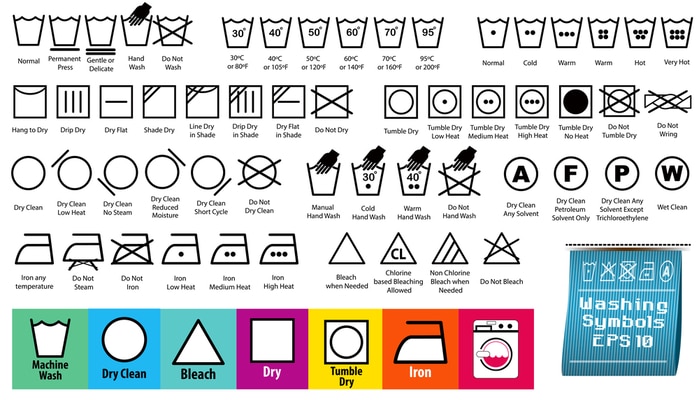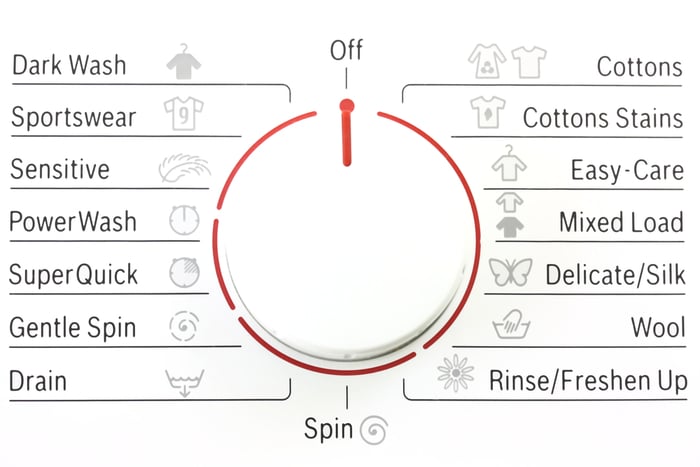We've independently reviewed this article to make sure it's as accurate as we can make it.
To find out more about our article creation and review process, check out our editorial guidelines.
Stuck trying to figure out what washer temperature is best for your clothes?
You’re not alone! Selecting the right water temperature can be a bit challenging. After all, making the wrong choice can result in damaged and dirty clothes.
Luckily, with the help of this washer temperature guide, you’ll learn all there is to know about different water temperatures.
To choose the right water temperature for your washer, consider that hot water is ideal for tough stains and dirt, while cold water is better for delicate fabrics and bright colors. Warm water is a great middle ground, offering effective cleaning power while protecting your clothes.
Keep reading this washer temperature guide to learn more!
Why trust us? This article was written by Craig Anderson and James Blackford.
Craig has helped thousands of other homeowners repair their appliances since 2016.
James is one of our resident appliance experts with over 16 years of experience. He currently works as a Master Technician for SquareTrade, and runs his own appliance repair business.
Difference Between Washer Water Temperatures
Choosing the right washer temperature can do more than just make your clothes look and feel good. It can also help you save money on your energy bills and take care of your clothes!
In this section, you’ll learn the main differences between hot, warm, and cold water to pick the temperature that best fits your needs.
Hot Water
I recommend using hot water in your washer if you have a pile of heavily soiled or stained clothes.
Hot water is also ideal for washing whites, towels, cotton tablecloths, and other non-delicate fabrics.

When you select the “Hot” setting, your washer heats the water to 130ºF or higher, which helps break down dirt and grime more effectively than cold water.
People often ask me why hot water is so effective at removing dirt and stains. It’s actually quite fascinating!
Heat causes molecules to move more quickly, weakening and separating the bonds between them. As a result, hot water can reach further into the fabric and loosen the dirt from the fibers, making it easier to remove.
Please keep in mind that hot water isn’t suitable for all types of clothes. Avoid using it for delicate fabrics like silk or wool and dyed clothes, as it can cause shrinking or fading.
It’s also worth mentioning that the higher the water temperature, the more energy is required to heat it.
So, if you often use hot water to wash your clothes, your energy bills will likely increase, which is not ideal if you’re trying to save some extra money.
Want to know exactly how much it costs to run your washer? Use our free calculator!
Warm Water
In my opinion, using warm water in your washer is ideal, as it’s effective at cleaning lightly soiled clothes and colored fabrics that can easily fade in hot water.
Warm water is typically set to around 90-110ºF. It’s a good compromise between hot and cold water.
Warm water is also perfect for those fabrics you’re not quite sure about – those that aren’t quite delicate, but you don’t want to risk hot water on them, either.
I always recommend reading the care label of your clothes before washing them. Some fabrics, such as wool, can still be too delicate for warm water.
While warm water is not as energy-efficient as cold water, it still gets the job done without using excessive amounts of energy.
Cold Water
My usual advice is to use cold water for delicate fabrics and bright-colored items that can easily shrink.
Typically, the temperature of cold water in a washing machine ranges from 60ºF to 80ºF.
Selecting the “Cold” temperature setting means your washer doesn’t have to use extra energy to heat water, which can help you save some extra bucks on your energy bill. Using cold water is also a great way to lower your carbon footprint and take care of the environment.
However, it’s important to keep in mind that cold water is not as effective as hot water when it comes to removing tough stains, such as oil, grease, or makeup.
So, while cold water is great for delicate, dark, and bright clothes, you’ll need to select a higher temperature for particularly soiled items.
Tips to Choose the Right Washer Temperature
Now that you’ve gone through this washer temperature guide, it’s time to delve into some specific tips that will help you choose the perfect water temperature for your clothes every time.
#1 Read the Care Label on Your Clothes
In my experience, the best way to ensure you’re using the right washer temperature is by reading the care label on your clothes.
Care labels have many symbols that can be tricky to understand. But don’t worry, I’ve got you covered! Here’s what they mean:

From what I’ve seen, the care label is typically located on the side seam or near the garment’s collar. Check the temperature symbols and pay attention to any special instructions.
You see, some care labels will instruct you to wash that specific item separately or with similar colors, which can influence your choice of water temperature.
#2 Sort Laundry By Fabric Type
The next step in ensuring you’re using the right washer temperature is to sort your laundry by fabric type.
I know it can be tempting to save time and energy by washing all your clothes together. However, it can actually do more harm than good.
Imagine washing your favorite silk blouse with denim jeans – that’s a recipe for disaster!
So, after you’ve checked the care labels, gather as many clothes of the same fabric as possible to complete a full load, aiming to keep your washer at 75% of its capacity. This way, you’ll protect your clothes and avoid wasting water and damaging your machine.
Then, choose the right washer temperature according to the fabric type.
#3 Consider the Level of Stains
To choose the right washer temperature, consider your clothes’ soil level or stains.
As discussed earlier, cold water is great for delicate items, but it’s not as effective as hot water when washing heavily soiled items.
By considering the level of soil and stains, you can determine the appropriate washer temperature that will effectively clean your clothes.
But what should you do when a delicate fabric is heavily stained?
It’s very common to encounter this dilemma, but don’t worry. Your best bet is to use a stain remover designed for your specific fabric. After treating the stain, wash your delicate garment in cold water.
Remember, you should never use hot water on delicate items!
If a stain remover doesn’t do the trick, I recommend taking your delicate stained item to a professional cleaner who can give it special care.
#4 Use Your Washer’s Settings
To choose the right washer temperature, it’s also important to familiarize yourself with the available settings.
You see, most washers have settings specifically designed for different fabric types, such as denim, colors, whites, baby clothes, sportswear, wool, and others.
These cycles will automatically adjust the washer temperature, time, and spin speed based on the fabric you need to wash.
So, if you’re unsure about the right washer temperature, choose the cycle that matches the fabric type, and let your washer do the work for you.

Please keep in mind that if you add too little or too much detergent, it won’t matter what cycle or temperature of water you pick – your clothes can still come out dirty.
So, please read the instructions on the detergent packaging or refer to the manufacturer’s manual to ensure you’re using the right amount of detergent.
Extra tip: Avoid overloading your washer, as this can cause your clothes to come out dirty or damaged.
Conclusion
Hopefully, this washer temperature guide has helped you learn how to choose the right water temperature for your laundry.
Remember, choose cold water for delicate and dyed garments and opt for hot water for heavily stained clothes.
Thank you so much for taking the time to read this quick guide. If you found it helpful, please check out our other related posts below.
Good luck!








